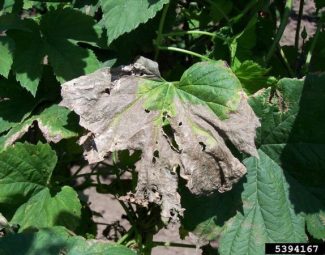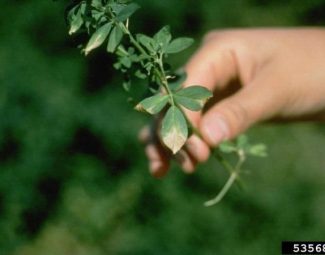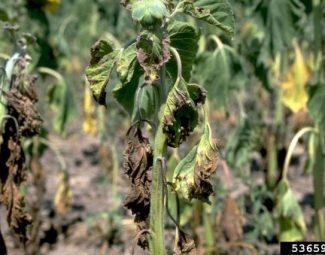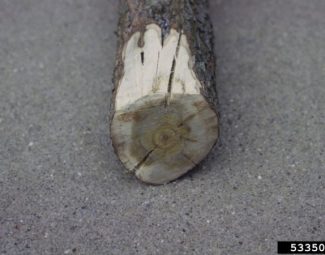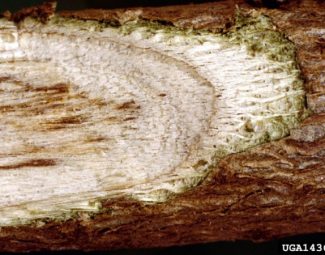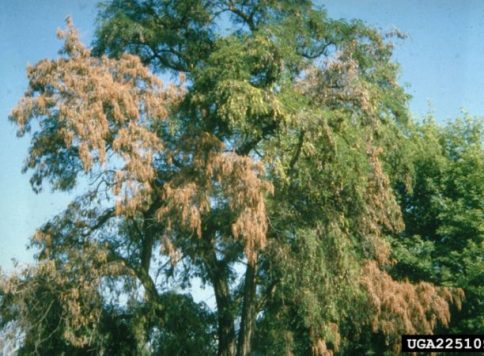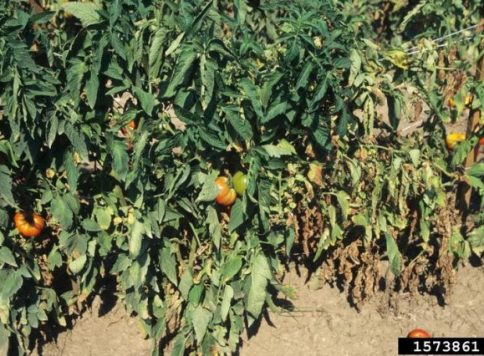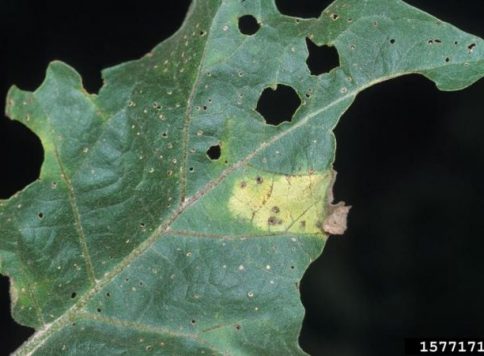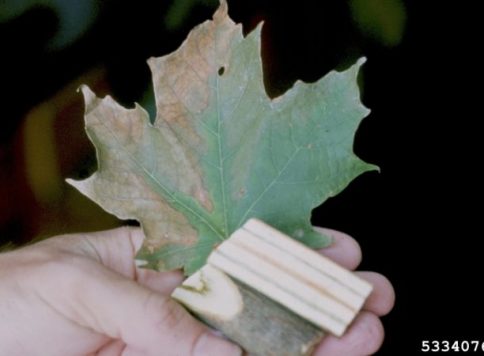Verticillium Wilt
Disease Summary Report
Verticillium albo-atrum
Verticillium dahliae
General Information
- Verticillium wilt is similar symptomatically to fusarium wilt.
- Hosts include over 300 species. Tomatoes, peppers, potatoes, eggplant, strawberries, and black raspberries are especially vulnerable. Other host species include: artichoke, beet, chicory, chrysanthemum, cotton, cucumber, endive, horseradish, mints, muskmelon, okra, peanuts, radish, rhubarb, and watermelon.
- Infect a wide variety of woody shrubs and trees.
- Weed hosts include: cocklebur, dandelion, lambsquarter, nightshade, pigweed, ragweed, and velvetleaf.
- Most monocots, cereal crops and grasses are immune.
- Lower leaves develop irregular yellow blotches, especially between veins, that eventually turn brown and die. Top leaves may remain green. Causes stunted plants and fruit.
- Like fusarium wilt, browning of the xylem tissue can be witnessed, but unlike fusarium, browning seldom extends beyond 10-12 inches above ground.
- Growth within xylem tissue impedes normal flow of water and nutrients from roots to upper parts of plants. Toxin produced by verticillium upon infection of host plant also contributes to wilting.
- Factors that contribute to host infection include: neutral to alkaline soils, water saturated soil for 1 day or more and soil temps. between 55-86 F with 75 F optimal.
- Disease is not known to be carried in seeds.
Disease Cycle
- Microsclerotia and mycelia develop hyphae when soil temps and moisture are suitable for survival. Hyphae invade plant through root tips. Often, will infect roots that have suffered damage due to insects, nematodes, machinery or other external injury.
- Develop fibrous mycelia or spores within the xylem tissue, which eventually impede or prevent normal water and mineral transfer from roots to upper parts of plant. Mycelia produce toxin that further promotes wilting.
- Spores and mycelia contained in dead plant tissue drop to the ground and serve as future sources of host crop inoculant.
Over wintering Strategy
Over winter as black thread-like structures called microsclerotia. These structures are produced while inside the host when environmental conditions are not conducive to survival and are capable of persisting in soil for many years. Microsclerotia is not developed in Verticillium albo-atrum. Instead, melanized mycelia are formed.
Organic Control
- Commonly Used Control Products
- Myco Seed Treat (Seed Treatment)
- Bac Pac (Seed Treatment)
- NRG Activate PMSLA (Biological)
- NRG Activate 2004 (Biological)
- AgriEnergy SP-1 (Biological)
- Actinovate (Biological)
- Terra Clean (Sterilizer)
- Residuce (Biological Crop Residue Digester)
Cultural Control
- Maintain good fertility and mineral balance in plants. Identify macro- and micronutrient deficiencies by performing plant tissue and soil analysis. Adjust for deficiencies with foliar and soil applied applications of appropriate fertilizers. Avoid high rates of Nitrogen fertilizers.
- Minimize factors that contribute to proliferation of inoculation such as: inoculated irrigation tail water from infected fields, dirty machinery, wind, erosion, transplants that are infected with verticillium, and mechanical and/or insect root injury.
- Avoid overwatering.
- Rotate verticillium resistant crops for 5 years or more, such as cereal grain or grasses.
- Control weeds that serve as hosts.
- Remove symptomatic plants or prune sections of diseased plants as soon as they are identified.
- Plant cultivars that have been identified as being verticillium resistant or immune. Often, a code is included on the seed label that indicates which diseases the seed variety is resistant against.
More Images of Verticillium Wilt
Bibliography
- Images by Howard F. Schwartz, Colorado State University, Bugwood.org (wilted sunflowers and damage to sunflower plant)
- Image by Gerald Holmes, California Polytechnic State University at San Luis Obispo, Bugwood.org (foliar symptoms and wilted tomato plants)
- Image by David Gent, USDA Agricultural Research Service, Bugwood.org (symptoms on hop plants)
- Image by William M. Brown Jr., Bugwood.org (symptoms on alfalfa plant)
- Image by Mary Ann Hansen, Virginia Polytechnic Institute and State University, Bugwood.org (vascular discoloration on smoke tree)
- Image by Roland J. Stipes, Virginia Polytechnic Institute and State University, Bugwood.org (symptoms on sugar maple leaf)
- Image by USDA Forest Service, Northern and Intermountain Region , USDA Forest Service, Bugwood.org (crown with wilt symptoms)
- Image by Clemson University – USDA Cooperative Extension Slide Series, Bugwood.org (damage to cotton stem)
- Barbara, D.J. & Clewes, E. (2003). “Plant pathogenic Verticillium species: how many of them are there?” Molecular Plant Pathology 4(4).297-305. Blackwell Publishing. (Host identification)
- cru.cahe.wsu.edu/CEPublications/eb1908/eb1908.pdf (microsclerotia absent in albo-atrum)
- http://plantpathology.tamu.edu/Texlab/Fiber/Cotton/cvw.html (disease not carried in seeds)
- Missouri Botanical Garden Kemper Center for Home Gardening http://www.mobot.org/gardeninghelp/plantfinder/IPM.asp?code=147&group=21&level=s (Life Cycle)
- http://vegetablemdonline.ppath.cornell.edu/factsheets/Tomato_Verticillium.htm (Optimal and range of temps., height of brown stem symptoms)
- http://www.umassvegetable.org/soil_crop_pest_mgt/disease_mgt/eggplant_verticillum_wilt.html (Neutral to alkaline soils)

